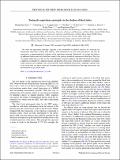Files in this item
Testing the equivalence principle via the shadow of black holes
Item metadata
| dc.contributor.author | Li, Chunlong | |
| dc.contributor.author | Yan, Sheng-Feng | |
| dc.contributor.author | Xue, Lingqin | |
| dc.contributor.author | Ren, Xin | |
| dc.contributor.author | Cai, Yi-Fu | |
| dc.contributor.author | Easson, Damien A. | |
| dc.contributor.author | Yuan, Ye-Fei | |
| dc.contributor.author | Zhao, Hongsheng | |
| dc.date.accessioned | 2022-11-11T10:30:13Z | |
| dc.date.available | 2022-11-11T10:30:13Z | |
| dc.date.issued | 2020-07 | |
| dc.identifier | 265148893 | |
| dc.identifier | 4579455a-c8db-482e-b8bd-41f9f5d1032d | |
| dc.identifier | 85112383666 | |
| dc.identifier | 000603585200003 | |
| dc.identifier.citation | Li , C , Yan , S-F , Xue , L , Ren , X , Cai , Y-F , Easson , D A , Yuan , Y-F & Zhao , H 2020 , ' Testing the equivalence principle via the shadow of black holes ' , Physical Review Research , vol. 2 , no. 2 , 023164 . https://doi.org/10.1103/PhysRevResearch.2.023164 | en |
| dc.identifier.issn | 2643-1564 | |
| dc.identifier.other | ArXiv: http://arxiv.org/abs/1912.12629v1 | |
| dc.identifier.other | ArXiv: http://arxiv.org/abs/1912.12629v2 | |
| dc.identifier.uri | https://hdl.handle.net/10023/26375 | |
| dc.description | Funding: H.Z. acknowledges support from the USTC fellowship for international visiting professors and from Shanghai Astronomical Observatory. This work is sup- ported in part by the NSFC (No. 11722327, No. 11653002, No. 11961131007, No. 11725312, No. 11421303), by the CAST (No. 2016QNRC001), by the National Youth Talents Program of China, and by the Fundamental Research Funds for Central Universities. The work of D.A.E. is supported in part by the Foundational Questions Institute. | en |
| dc.description.abstract | We study the equivalence principle, regarded as the cornerstone of general relativity, by analyzing the deformation observable of black hole shadows. Such deformation can arise from new physics and may be expressed as a phenomenological violation of the equivalence principle. Specifically, we assume that there is an additional background vector field that couples to the photons around the supermassive black hole. This type of coupling yields impact on the way the system depends on initial conditions and affects the black hole shadow at different wavelengths by a different amount, and therefore observations of the shadow in different wavelengths could constrain such couplings. This can be tested by future multiband observations. Adopting a specific form of the vector field, we obtain constraints on model parameters from Event Horizon Telescope observations and measurements of gas/stellar orbits. | |
| dc.format.extent | 11 | |
| dc.format.extent | 772057 | |
| dc.language.iso | eng | |
| dc.relation.ispartof | Physical Review Research | en |
| dc.subject | QB Astronomy | en |
| dc.subject | QC Physics | en |
| dc.subject | 3rd-DAS | en |
| dc.subject.lcc | QB | en |
| dc.subject.lcc | QC | en |
| dc.title | Testing the equivalence principle via the shadow of black holes | en |
| dc.type | Journal article | en |
| dc.contributor.institution | University of St Andrews. School of Physics and Astronomy | en |
| dc.identifier.doi | https://doi.org/10.1103/PhysRevResearch.2.023164 | |
| dc.description.status | Peer reviewed | en |
| dc.identifier.url | http://arxiv.org/abs/1912.12629 | en |
This item appears in the following Collection(s)
Items in the St Andrews Research Repository are protected by copyright, with all rights reserved, unless otherwise indicated.

